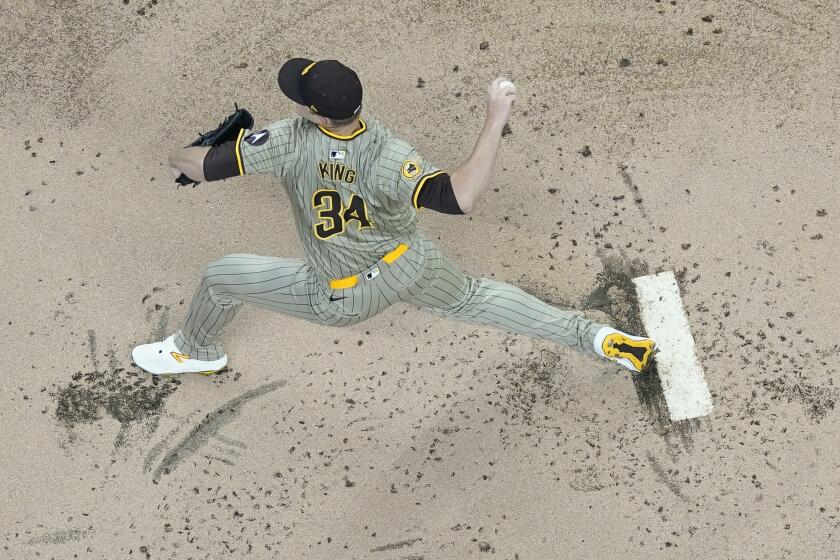Chargers can see themselves in Vikings’ new stadium
A reflection of the downtown skyline can be seen in the glass exterior of U.S. Bank Stadium.
It provides for a unique sort of selfie opportunity, where one can capture themselves and the skyscrapers towering a half-mile behind them.
For the Spanos family, some of whom will tour the NFL’s newest and fourth-most-expensive stadium this weekend, the hope will be that they are glimpsing in this edifice their own team’s future.
If they weren’t to believe that, then Sunday would basically just be rubbing salt in their wounds.
The owners of the Chargers in January were denied in their attempt to move to Los Angeles and are currently campaigning to try to persuade San Diego voters to approve a hotel tax hike to help build a downtown stadium and convention center.
And on Sunday, their team will play in the first football game in the Minnesota Vikings’ new stadium.
What the Chargers brass will see is the next step in stadium intimacy, a building designed to reflect local sensibilities and contain the most modern amenities and give maximum accessibility and also to feel like a living room.
What the “Measure C” brain trust should do, perhaps instead of all the phone calls and knocking on doors, is fly all those undecided voter they have targeted to Minneapolis this fall.
Envision sitting in a dank garage with the stench of dead mice in the walls, staring at a black-and-white television that has to be slapped on its side every once in a while. Then envision sitting in a sensibly lit home, on a couch that gives you a comfortable hug, feet on an ottoman, someone bringing you food and drinks, beholding a 90-inch high-definition flat screen with surround sound.
You just envisioned going from Qualcomm Stadium to U.S. Bank Stadium, where the seeimgly impossible task of making thousands of seats seem like the best ones in the house is accomplished.
What San Diegans can see here, more than anything, is what can actually come from a decade-plus battle.
“It wasn’t easy, that’s for sure,” Vikings stadium point man/crusader Lester Bagley said Friday at one point on a walk through various concourses and clubs. “The process was so brutal – the 12 years at the capitol, and even the last four years were not roses. But this building is so incredible. It’s in inverse proportion to how we got here. I think San Diego is going to feel the same way. That has been a long brawl, as was this. But look at it now.”
As should be ensured by $1.1 billion -- $498 million of it public funds approved by state and local legislators, with that financing coming from gambling, cigarette, convention and corporate taxes – it is magnificent.
Every new stadium tops the last. And that evolution isn’t just about enhanced technology and opulence. It is in the way that teams have made it a priority to have their home stadium reflect their home market and make their fans feel at home.
As it stands out when in the San Francisco 49ers’ Levi’s Stadium how much of their material was repurposed and their emphasis on being “green,” the rustic Norwegian influence and chic austerity are paramount here.
The exterior of the stadium portrays the image of shards of ice broken off in a thawing lake. Its 1.75 million square feet are arranged in a rectangle with a pitched roof, very much like a Viking house, best allowing for the shedding of snow.
Inside, the minimal light that is dimmed by the opaque roof – composed of the same polymer that would enclose the Chargers’ proposed stadium – is made up for by the ribbon of glass near the top of the stadium and the 95-foot glass doors at one end that will be open Sunday and whenever weather allows. It’s a virtual outdoors.
There are 131 suites, ranging in price from $150,000 to $400,000. That includes 23 suites ringing the field, closer than any such suites in the league. They are separated from the playing surface by a low countertop that sits 25 feet from the sideline. The owners of those suites have access to a club area through which Vikings players will march to and from the field for pregame warm-ups and before and after each half. At one edge of the club, just outside the Vikings locker room, is a glassed-off room in which the Vikings head coach will conduct his postgame press conference. At his behest, the window can be whited out, but the plan is for people in the club to be able to see and hear the press conference.
It is the premium seating and club areas that set apart each new stadium.
Here, it is the couches in Club Purple that personify the execution of what has become the primary goals of every team in its stadium construction or rehabilitation. That is, a setting that makes people feel at home, both in ambience and convenience, and that provides an experience as convenient and comfortable and augmented as sitting in a man cave in front of the HD big screen.
The purple Club Purple couches, in a living room setting, might be the coolest location from which to watch an NFL game anywhere. The line of sight to the field 50 feet below and the gigantic video board to the right is unparalleled. But it the club is austerely decorated, modestly Minnesota.
The simplicity, intimacy and provincial touches are similar to what is suggested in the conceptual renderings of the proposed Chargers facility.
Of the 66,655 seats in U.S. Bank Stadium, 49,000 required stadium builders’ licenses – what the Vikings call their 49,000 personal seat licenses. The average cost was $2,500 with a range from $500 to 9,500. That compares to the $2,000 to $80,000 range at Levi’s Stadium.
“Our seat licenses were priced to fit the area,” Bagley said.
That is what the Chargers will promise, and what they will have to do if they hope to thrive in their planned 61,500-seat venue.
The Vikings announced Friday that the 66,655-seat stadium is sold out for the season.
Of the nearly 1,000 events booked for the remained of the year, 10 are Vikings games. The stadium will host the Super Bowl in 2018 and NCAA Final Four in 2019.
An essentially abandoned edge of downtown is beginning to draw development, including housing and two 17-story towers built by Wells Fargo. Some 5,000 workers populate the buildings during the week, and the building’s parking spaces will be used on game days.
There is a lot for those hoping for hope to see.
It at least shows what can be accomplished.






